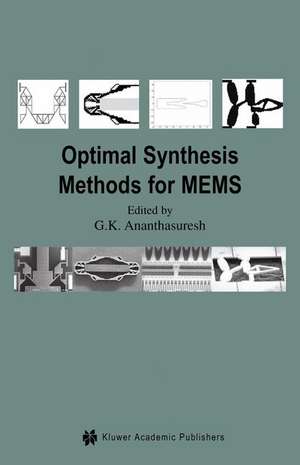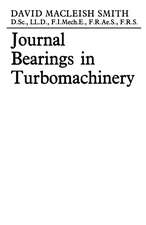Optimal Synthesis Methods for MEMS: Microsystems, cartea 13
Editat de S.G.K. Ananthasureshen Limba Engleză Hardback – 30 noi 2003
| Toate formatele și edițiile | Preț | Express |
|---|---|---|
| Paperback (1) | 946.41 lei 43-57 zile | |
| Springer Us – 13 sep 2013 | 946.41 lei 43-57 zile | |
| Hardback (1) | 952.72 lei 43-57 zile | |
| Springer Us – 30 noi 2003 | 952.72 lei 43-57 zile |
Din seria Microsystems
- 18%
 Preț: 941.05 lei
Preț: 941.05 lei - 15%
 Preț: 640.55 lei
Preț: 640.55 lei - 5%
 Preț: 1105.04 lei
Preț: 1105.04 lei - 15%
 Preț: 643.34 lei
Preț: 643.34 lei - 15%
 Preț: 639.73 lei
Preț: 639.73 lei - 18%
 Preț: 950.03 lei
Preț: 950.03 lei - 18%
 Preț: 951.29 lei
Preț: 951.29 lei - 5%
 Preț: 1111.09 lei
Preț: 1111.09 lei -
 Preț: 430.69 lei
Preț: 430.69 lei - 20%
 Preț: 1000.38 lei
Preț: 1000.38 lei - 15%
 Preț: 640.06 lei
Preț: 640.06 lei - 18%
 Preț: 952.72 lei
Preț: 952.72 lei - 15%
 Preț: 638.76 lei
Preț: 638.76 lei - 15%
 Preț: 640.71 lei
Preț: 640.71 lei - 15%
 Preț: 638.57 lei
Preț: 638.57 lei - 15%
 Preț: 640.37 lei
Preț: 640.37 lei - 15%
 Preț: 638.43 lei
Preț: 638.43 lei - 15%
 Preț: 643.34 lei
Preț: 643.34 lei - 18%
 Preț: 954.77 lei
Preț: 954.77 lei
Preț: 952.72 lei
Preț vechi: 1161.85 lei
-18% Nou
Puncte Express: 1429
Preț estimativ în valută:
182.31€ • 190.82$ • 151.73£
182.31€ • 190.82$ • 151.73£
Carte tipărită la comandă
Livrare economică 31 martie-14 aprilie
Preluare comenzi: 021 569.72.76
Specificații
ISBN-13: 9781402076206
ISBN-10: 1402076207
Pagini: 320
Ilustrații: XIII, 320 p. 187 illus.
Dimensiuni: 155 x 235 x 21 mm
Greutate: 0.65 kg
Ediția:2003
Editura: Springer Us
Colecția Springer
Seria Microsystems
Locul publicării:New York, NY, United States
ISBN-10: 1402076207
Pagini: 320
Ilustrații: XIII, 320 p. 187 illus.
Dimensiuni: 155 x 235 x 21 mm
Greutate: 0.65 kg
Ediția:2003
Editura: Springer Us
Colecția Springer
Seria Microsystems
Locul publicării:New York, NY, United States
Public țintă
ResearchCuprins
1 Introduction.- 1. Design of Microelectromechanical Systems.- 2. Synthesis vs. Analysis.- 3. Optimization as a synthesis tool.- 4. Contents of the chapters.- 5. Closure.- 2 Synthesis for Mechanical Behavior.- 1. Introduction.- 2. Synthesis of beam-like structures.- 3. Topology Synthesis.- 4. Synthesis for dynamic attributes.- 5. Conclusions.- 3 Synthesis of Electrostatically Actuated Mems.- 1. Introduction.- 2. Governing Equations.- 3. Shape Synthesis of Electrostatically Driven Actuators.- 4. An Example: Variable Comb-drive Actuators.- 5. Closure.- 4 Synthesis Methods for Electrothermal Actuation.- 1. Introduction.- 2. Generalization of the BasiC electro-thermal actuator.- 3. Modeling.- 4. Synthesis.- 5. Numerical examples.- 6. Alternative implementation using “line elements”.- 7. Advanced example.- 8. MicroFabrication.- 9. Closure.- 5 Synthesis with Piezoelectric Actuation.- 1. Introduction.- 2. Background Theory for Piezoelectricity.- 3. FEM Applied to Piezoelectricity.- 4. Flextensional Actuator Design.- 5. Conclusion.- 6 Synthesis of Piezocomposites.- 1. Piezocomposite Design.- 2. Homogenization Method.- 3. Piezocomposite Design Problem.- 4. Examples.- 5. Conclusions.- 7 Synthesis of Periodic Micro Mechanisms.- 1. Introduction.- 2. Numerical homogenization, FE modeling, and sensitivity analysis.- 3. Formulation of the problem.- 4. Numerical implementation.- 5. Examples.- 6. Wave propagation.- 7. Concluding remarks.- 8 Process Synthesis.- 1. Introduction.- 2. State-space representation.- 3. Planar device representation.- 4. Basic synthesis method.- 5. Cardinality of design space.- 6. Granularity control through condensation.- 7. Other miscellaneous graph-theoretical results.- 8. Process flow construction.- 9. Determination of selective operators.- 10. Processflow parameters.- 11. Software implementation.- 12. Compiler testing.- 13. Summary.- 9 Mask Synthesis.- 1. Introduction.- 2. Related work.- 3. Mathematical framework.- 4. Synthesis.- 5. Examples.- 6. Conclusions.- 10 System-Level Synthesis.- 1. MEMS Design representations.- 2. Synthesis Methodology.- 3. Performance Models.- 4. Synthesis Results.- 5. Summary.
















